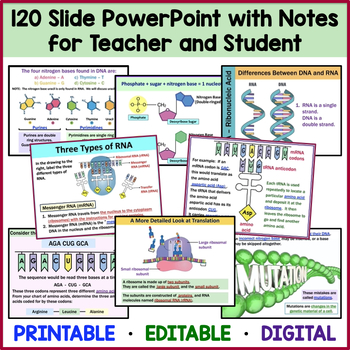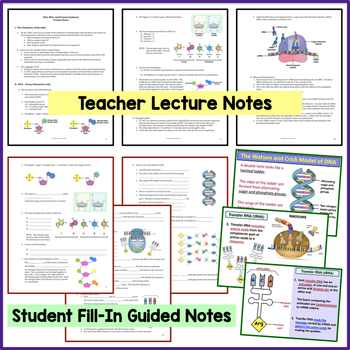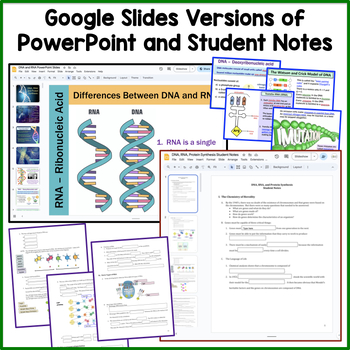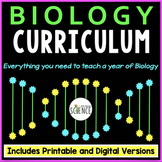DNA RNA Protein Synthesis Powerpoint and Notes
- Zip
- Google Apps™
- Microsoft OneDrive

What educators are saying
Also included in
- This complete teaching unit on DNA, RNA, and Protein Synthesis includes everything you need to teach this unit to your life science or biology students. Resources include a 120-slide PowerPoint presentation packed with colorful and interesting photographs and images, teacher notes, printable and diPrice $49.99Original Price $67.95Save $17.96
- This NO PREP, PRINTABLE, EDITABLE, AND DIGITAL Biology Curriculum contains everything you need for an entire year of Biology! For less than $3 a day, you can save your time, energy, and sanity. Each of the 20 Complete Units includes a teaching PowerPoint presentation, notes, labs, homework assignmenPrice $525.00Original Price $988.18Save $463.18
Description
This PowerPoint with Notes for Teacher and Student will ensure that your students master the concepts of DNA, RNA and protein synthesis taught in a typical high school biology class. The PowerPoint includes the historical work of Chargaff, Rosalind Franklin, and Watson and Crick, the structure and replication of DNA, the transcription of RNA, the deciphering of the genetic code during protein synthesis, and so much more. See complete list of topics below. These 120 slides will captivate your students with stunning photos and diagrams to provide an in-depth study of these topics. Choose to use the traditional printable version, or the paperless, digital Google Apps version.
What is included in this product?
- A 120-Slide PowerPoint Presentation (Includes traditional PowerPoint, PDF, and Google slides)
- Editable and printable 18-page set of lecture notes for the teacher
- Editable and printable 23-page guided notes outline for the student
- Paperless Digital Version (Google Slides) for use in Google Drive, Google Classroom, and /or Microsoft OneDrive
- Teacher Guide for google Apps
The Power Point is designed to hold the attention of your students. The 120 slides are bright and colorful and contain loads and loads of visually appealing pictures and images. Animations and transitions are included to allow you to control the pace of the lesson.
Your students are going to love using the outline as you teach. It allows the student more freedom to listen, think, and ask questions during note-taking. The notes are also perfect for students with disabilities or IEP's.
Topics covered by this PowerPoint include:
- History of DNA Studies: Early concepts about genes, roles played by genes, Watson and Crick, Chargaff, Rosalind Franklin, Maurice Wilkins.
- DNA nucleotides and their composition, purines, pyrimidines, how nucleotides are joined to one another, nitrogen bases.
- Chargaff’s Rules and the X-Ray evidence by Rosalind Franklin
- The Watson and Crick model of DNA, the double helix, the base pairing rules, DNA as a carrier of information.
- Mechanisms by which a large amount of DNA can fit inside a small space of the nucleus, histones, nucleosomes.
- Replication of DNA: Drawings, steps in replication, DNA polymerase, hydrogen bonds, origins or replication, replication forks, complementary strands, helicase.
- Proofreading and repairing DNA: the role of polymerases, nucleases, and ligases.
- The Genetic Code: codons, amino acids.
- RNA: Differences between DNA and RNA, the functions of RNA, the three types of RNA (mRNA, tRNA, rRNA).
- Transcription: Purpose of transcription, steps to transcription, promoter, terminator, RNA polymerase.
- RNA processing and editing, introns, exons.
- Understanding the genetic code, how codons translate into amino acids, start codons, stop codons, reading a table of codons.
- Translation: protein synthesis, ribosomes, steps in translation, the role of mRNA and the role of tRNA, structure of tRNA and its ability to transport amino acids, reading and deciphering the code.
- Practice Problem: Given a DNA sequence, students will figure out the corresponding mRNA codon sequence, the tRNA anticodon sequence, and the amino acid sequence.
- Ribosome structure: large subunit, small subunit, RNA binding sites, the entry and exit of tRNA to build a polypeptide, start codons, stop codons.
- Mutations: definition of mutation, gene mutations, chromosome mutations, point mutations, base substitutions, base insertions or deletions, silent mutations, frameshift mutations, the importance of mutations in natural selection.
This PowerPoint and Notes set is so complete and comprehensive it can be used in place of a textbook. If you are already using a textbook you love, the PowerPoint and notes are editable and are easily incorporated into your existing lessons and units.
Also included is a chart of all 64 codons and the amino acids they code for.
Related resources include:
DNA, RNA, and Protein Synthesis Bundle
DNA, RNA, and Protein Synthesis Google Sheets Hidden Picture Reveal Games
Biology Buzz Words: DNA, RNA, and Protein Synthesis
DNA, RNA, and Protein Synthesis Warm Ups and Bell Ringers
Lab: Translation and Protein Synthesis Determining Traits of Mystery Organism
DNA, RNA and Protein Synthesis Crossword Puzzle
Test: DNA, RNA, and protein synthesis
DNA Quiz or Homework (Advanced)
Crossword Puzzle: DNA and Replication
RNA and Transcription Crossword Puzzle
Translation and Protein Synthesis Crossword Puzzle
DNA, RNA and Protein Synthesis Worksheet or Study Guide
DNA, RNA, Protein Synthesis Set of 4 Homework Assignments
Homework #1: The Basics of DNA
Homework #3: RNA and Transcription
Homework #4: Protein Synthesis and Translation
Free DNA Informational Text with Graphic Organizers
DNA, RNA, Protein Synthesis - Set of 3 quizzes
Quiz #2: RNA and Transcription
Quiz #3: Translation and Protein Synthesis
RNA and Transcription Powerpoint Jeopardy Review Game
Translation and Protein Synthesis Powerpoint Jeopardy Review Game
DNA and RNA Powerpoint Jeopardy REview Games - Set of Three Games
Test: RNA, transcription and translation
FREE Chart of Amino Acids and Their Codons
For updates about sales and new products, please follow my store:







